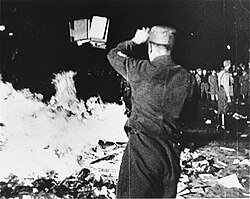Fahrenheit 451
Fahrenheit 451 is an American dystopian fiction novel. It was written by Ray Bradbury and first published in 1953.
The novel is about a future American society in which people are hedonistic (meaning they live only for pleasure), and reading is against the law because it makes them think. The main character, Guy Montag, has a job as a "fireman" (which, in this future, means "book burner"). The number "451" refers to the temperature (in Fahrenheit) at which the books burn[1] when the "firemen" burn them "for the good of humanity". Written in the early years of the Cold War, the novel is a critique of what Bradbury saw as an increasingly dysfunctional American society.
The idea began with Bradbury's short story "Bright Phoenix," written in 1947 but first published in the Magazine of Fantasy and Science Fiction in 1963.[2] The original short story was reworked into the novella, The Fireman, and published in the February 1951 issue of Galaxy Science Fiction. The novel was also serialized in the March, April, and May 1954 issues of Playboy magazine.[2] Bradbury wrote the entire novel on a pay typewriter in the basement of UCLA's Powell library. His original idea in writing Fahrenheit 451 was to show his great love for books and libraries. He has often referred to Montag as an allusion to himself.
Over the years, the novel has been subject to various interpretations, primarily focusing on the historical role of book burning in suppressing dissenting ideas. Bradbury has said that the novel is not about censorship; he says that Fahrenheit 451 is a story about how television destroys interest in reading literature, which leads to people thinking that knowledge is made up of "factoids", partial information without context, such as Napoleon's birth date alone, without an indication of who he was.[3][4]
A movie version of the novel was released in 1966, and at least two BBC Radio 4 dramatizations have also been aired, both of which follow the book very closely.
References
- ↑ Borch, Jens; Lyne, M. Bruce; Mark, Richard E.; Habeger, Charles (2001). Handbook of Physical Testing of Paper. CRC Press. p. 406. ISBN 978-0-203-91049-8.
- ↑ 2.0 2.1 "About the Book: Fahrenheit 451". The Big Read. National Endowment for the Arts. Archived from the original on 2012-05-11. Retrieved 2009-02-23.
- ↑ Bradbury, Ray About Freedom Archived 2011-10-18 at the Wayback Machine, raybradbury.com, Date unknown
- ↑ Boyle Johnston, Amy E. "Ray Bradbury: Fahrenheit 451 Misinterpreted"
Fahrenheit 451 Media
The Nazi book burnings horrified Ray Bradbury and inspired him to write Fahrenheit 451
Mageina Tovah, Ray Bradbury, David Mauer (Montag), Jessica D. Stone (Clarisse), Michael Prichard (Captain Beatty) and Roses Prichard backstage of Fahrenheit 451 by the Pandemonium Theatre Company at the Fremont Centre Theatre, Pasadena, California in August 2008
A protester against the Bhagavad Gita trial in Russia showing a quote from the novel: "– Do you ever read any of the books you burn? – That's against the law".
Archived 2007-07-12 at the Wayback Machine, LA Weekly, May 30, 2007.


